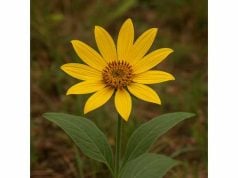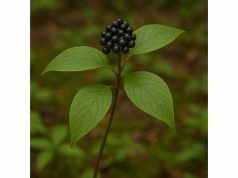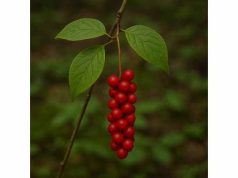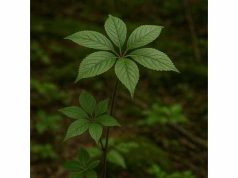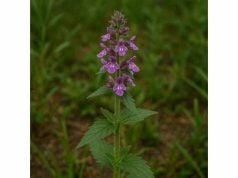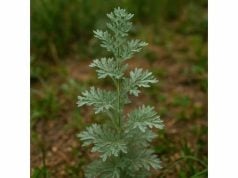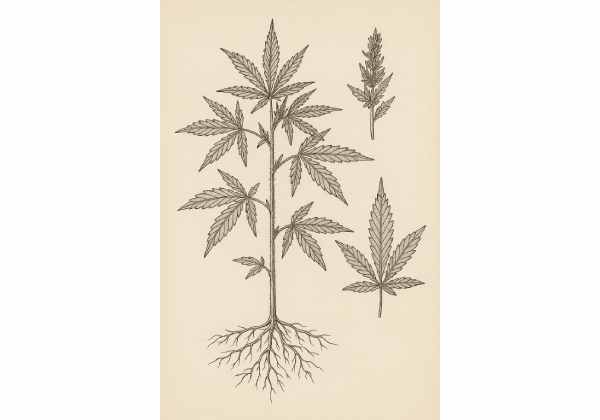
“Weed” is a term that has many meanings, but in the context of herbal medicine and wellness, it most often refers to Cannabis sativa and its relatives—plants with a rich tradition of therapeutic and cultural significance. Weed is renowned for its wide-ranging medicinal properties, attributed to its abundance of active compounds like cannabinoids (THC, CBD), terpenes, and flavonoids. These natural substances support pain relief, relaxation, sleep quality, appetite, and overall wellness. From traditional medicine to modern science, weed’s applications span physical, mental, and emotional health, making it a versatile herb valued for both preventive and targeted healing uses.
Table of Contents
- Botanical Characteristics and Natural History
- Active Ingredients and Phytochemical Spectrum
- Comprehensive Health Benefits and Intrinsic Properties
- Therapeutic Applications, Guidelines, and Safety
- Scientific Discoveries and Contemporary Research
- FAQ
Botanical Characteristics and Natural History
Let’s begin by understanding weed from a botanical perspective, exploring its plant profile, identifying features, habitat, and cultural roots.
Taxonomy & Classification
- Family: Cannabaceae
- Genus: Cannabis
- Species: Most commonly Cannabis sativa, Cannabis indica, and Cannabis ruderalis
- Common Names: Weed, marijuana, cannabis, hemp, ganja, pot, herb
Physical Characteristics
- Growth Habit: Herbaceous annual; can grow from 1–5 meters in height, depending on variety and cultivation.
- Leaves: Distinctive palmate leaves with serrated edges; typically 5–9 leaflets per leaf, vibrant green.
- Flowers: Small, greenish, with dense clusters; female flowers are more resinous and produce most of the plant’s medicinal components.
- Stems: Hollow, fibrous, strong—especially in hemp varieties.
- Seeds: Small, hard, and brownish, high in nutrients and healthy oils.
Natural Habitat & Growing Conditions
- Climate: Thrives in warm, sunny climates with moderate rainfall.
- Soil: Prefers well-drained, nutrient-rich soils.
- Distribution: Originally native to Central Asia, now cultivated worldwide.
History & Cultural Significance
- Used for millennia as a source of fiber (hemp), food, medicine, and for ritual or recreational purposes.
- Deeply embedded in many traditional medical systems, including Chinese, Ayurvedic, and Unani medicine.
- In modern times, both stigmatized and celebrated for its psychoactive and therapeutic potential.
Types of Weed (Cannabis)
- Sativa: Tall, uplifting, and energizing; often associated with daytime use.
- Indica: Shorter, more sedative; preferred for nighttime or relaxation.
- Hybrid: Crossbreeds that combine characteristics of sativa and indica.
- Ruderalis: Short, hardy, less psychoactive, used in breeding for autoflowering traits.
Cultivation Practices
- Vary by intended use (fiber, seed, medicinal, or recreational).
- Grown indoors or outdoors, with attention to light, nutrients, and pest management for optimal potency.
Weed’s versatility, hardiness, and rich heritage make it one of the world’s most remarkable herbal plants.
Active Ingredients and Phytochemical Spectrum
The health effects and medicinal applications of weed are due to its robust and unique phytochemical content. Here’s a closer look at the most significant active ingredients and what they do:
- THC (Δ9-Tetrahydrocannabinol)
- The primary psychoactive compound; interacts with the body’s endocannabinoid system to modulate pain, mood, appetite, memory, and perception.
- CBD (Cannabidiol)
- Non-psychoactive; provides anti-inflammatory, anxiolytic (anxiety-reducing), anticonvulsant, and neuroprotective effects. CBD is often favored for medicinal use.
- CBG (Cannabigerol)
- A “minor” cannabinoid with anti-inflammatory, antibacterial, and neuroprotective properties; thought to support mood, bladder health, and inflammation regulation.
- CBC (Cannabichromene)
- Works in synergy with other cannabinoids; anti-inflammatory, analgesic, and antidepressant effects.
- CBN (Cannabinol)
- Slightly psychoactive; occurs in aged cannabis, with noted sedative and potential antibacterial benefits.
- Terpenes (including Myrcene, Limonene, Pinene, Linalool)
- Aromatic compounds responsible for the plant’s distinct scent and much of its therapeutic character (e.g., relaxation, alertness, anti-anxiety, anti-inflammatory actions).
- Flavonoids (Cannflavin A, B, and C)
- Powerful antioxidants that may help modulate inflammation, protect against oxidative stress, and enhance overall wellness.
- Omega Fatty Acids (in seeds)
- Seeds contain high levels of essential fatty acids (omega-3 and omega-6), supporting heart, brain, and skin health.
- Vitamins & Minerals
- Vitamin E, B-vitamins, magnesium, potassium, iron, and zinc are present, especially in hemp seed.
Synergy in Action
- These active compounds work together—this “entourage effect” may enhance benefits and moderate adverse effects.
Comprehensive Health Benefits and Intrinsic Properties
Weed offers a wide array of health benefits, thanks to its diverse active compounds and interactions within the human body. Here’s a breakdown of its most recognized advantages:
Pain Relief
- Cannabinoids, especially THC and CBD, modulate pain perception in the brain and nervous system, making weed effective for chronic pain, neuropathy, and musculoskeletal disorders.
Anti-Inflammatory Action
- CBD, CBG, and other compounds help reduce systemic inflammation, making it useful for arthritis, inflammatory bowel conditions, and post-injury recovery.
Anxiety and Stress Relief
- Weed (especially CBD-rich strains) supports relaxation, eases stress, and promotes emotional balance.
Sleep Support
- Sedative effects, particularly from indica strains and CBN, aid those struggling with insomnia or disrupted sleep patterns.
Appetite Stimulation
- THC is well-known for increasing appetite (“the munchies”), making it beneficial in wasting syndromes, cancer, or HIV/AIDS.
Anti-Nausea and Vomiting
- Recognized as an effective antiemetic, especially for chemotherapy or medication-induced nausea.
Neuroprotection
- CBD, THC, and other cannabinoids show promise in protecting the brain and nerves from oxidative damage and degeneration—potentially relevant for conditions like epilepsy, multiple sclerosis, and Parkinson’s disease.
Seizure Reduction
- High-CBD products have been shown to reduce the frequency and severity of seizures, especially in childhood epilepsy syndromes.
Immune Modulation
- Cannabinoids may balance immune system responses, which can be helpful in autoimmune conditions.
Digestive Support
- Weed may soothe gut spasms, regulate motility, and reduce cramping in IBS and Crohn’s disease.
Antioxidant Properties
- Flavonoids and terpenes combat free radical damage, supporting overall health and longevity.
Cardiovascular Support
- Omega fatty acids in seeds may support heart health by reducing inflammation and balancing cholesterol.
Mental and Emotional Wellness
- Modulates neurotransmitters, which can lift mood and help in depression, PTSD, and other mood disorders.
Other Traditional and Modern Uses
- Relief from menstrual cramps, migraines, and certain skin conditions.
- Topical preparations for localized pain, eczema, and psoriasis.
Weed’s multi-system benefits reflect the intricate relationship between its natural compounds and our own physiology.
Therapeutic Applications, Guidelines, and Safety
Weed’s versatility shines through in its many applications, from traditional preparations to high-tech extracts. Let’s explore how to use it safely and effectively:
Common Methods of Use
- Inhalation (smoking/vaporizing): Rapid onset, suitable for pain, anxiety, and acute symptoms.
- Edibles: Infused oils, butters, and foods; slower onset, longer duration—ideal for chronic issues.
- Tinctures and Extracts: Alcohol- or oil-based extracts for precise dosing.
- Topicals: Creams, balms, or oils for localized relief of pain or inflammation.
- Capsules/Tablets: Standardized dosing, convenient for ongoing use.
- Raw Use: Fresh leaves or seeds in salads or smoothies (non-psychoactive).
Practical Usage Tips
- Start Low, Go Slow: Begin with a small dose to gauge your response, especially if you’re new to cannabis.
- Choose the Right Strain: Sativa for energy and focus, indica for relaxation, hybrid for balance.
- Consider Delivery Method: Edibles and capsules for sustained effects; inhalation for rapid relief.
- Keep Track: Journal your experiences to find what works best for you.
Dosage Recommendations
- Vary widely by product, route, and individual; always follow professional guidelines or product labeling.
- Edibles: 2.5–10 mg THC/CBD is a typical starting dose.
- Tinctures: 0.5–1 mL, titrated as needed.
- Topicals: Apply as needed to affected areas.
Preparation Methods
- Decarboxylation (gentle heating) activates THC/CBD for edible or extract use.
- Infusions with oil or butter for culinary purposes.
- Extraction with alcohol or CO2 for concentrated tinctures.
Safety, Contraindications, and Risks
- Short-Term Effects: Dry mouth, dizziness, altered perception, euphoria, or anxiety (especially with high-THC strains).
- Potential Interactions: May affect blood pressure, heart rate, and interact with sedatives, blood thinners, and some psychiatric medications.
- Mental Health Cautions: High doses or potent THC strains may worsen anxiety, paranoia, or psychosis in vulnerable individuals.
- Pregnancy/Breastfeeding: Avoid use due to potential risks.
- Addiction and Dependence: Regular use can lead to tolerance and mild dependence in some individuals.
- Legal Considerations: Cannabis legality varies by country and region—always follow local laws.
Best Practices
- Use only lab-tested, contaminant-free products.
- Store securely, out of reach of children or pets.
- Consult a qualified healthcare provider if you have medical conditions or take prescription medications.
Used mindfully, weed can be a safe and effective tool for wellness.
Scientific Discoveries and Contemporary Research
Ongoing research continues to reveal new facets of weed’s medicinal properties and applications. Recent studies highlight its potential and inform safe, effective use:
- 2024 – “Efficacy of Cannabinoids for Chronic Pain Management”
- Found significant pain reduction and improved quality of life in chronic pain patients using medical cannabis.
- 2023 – “CBD for Anxiety and Mood Disorders”
- Large clinical trial demonstrated notable anxiety reduction and improved sleep in adults using CBD oil.
- 2022 – “Cannabis Use and Epileptic Seizures in Pediatric Patients”
- Showed a 50%+ reduction in seizure frequency with high-CBD preparations, especially in rare childhood epilepsy.
- 2021 – “Topical Cannabinoids for Inflammatory Skin Diseases”
- Documented improvements in eczema, psoriasis, and dermatitis with cannabinoid-based creams.
- 2020 – “Endocannabinoid System and Immune Modulation”
- Explored how cannabinoids balance immune responses and reduce inflammation in autoimmune conditions.
- 2019 – “Cannabis for Cancer Symptom Management”
- Confirmed cannabis’s role in relieving pain, nausea, and appetite loss in cancer care.
- 2018 – “Neuroprotective Actions of CBD and THC”
- Provided evidence for brain-protective and anti-inflammatory effects relevant to MS, Parkinson’s, and Alzheimer’s.
Research continues to validate weed’s therapeutic value while highlighting the importance of individualized, responsible use.
FAQ
What are the top weed benefits for health?
Weed benefits include pain relief, reduced inflammation, anxiety support, sleep improvement, appetite stimulation, seizure control, and immune modulation. Its active compounds make it a versatile medicinal plant for holistic wellness.
How is weed used for medicinal purposes?
Weed is used as a tea, oil, tincture, edible, smoked or vaporized product, and in topical forms for pain, anxiety, sleep, and more. Choose the right delivery method and dose for your needs.
What are the key active compounds in weed?
Cannabinoids like THC, CBD, CBG, and terpenes are the main active compounds. They work synergistically to deliver therapeutic benefits while minimizing side effects when used mindfully.
Is weed safe for everyone?
While generally safe for most adults, weed may cause side effects, interact with medications, and is not recommended during pregnancy or for people with certain mental health conditions. Always consult a healthcare professional.
What are the potential side effects of weed?
Common side effects include dry mouth, dizziness, altered perception, increased appetite, or anxiety. Overuse may lead to dependence, so moderation is key.
Is weed legal to use for health purposes?
Laws vary by location. Many places permit medical use, while others have restrictions. Check local regulations before obtaining or using weed medicinally.
Disclaimer:
This article is for educational purposes only and is not a substitute for medical advice. Always consult a licensed healthcare provider before using weed or any herbal remedy, especially if you have underlying health conditions, are pregnant, or take prescription medications.
If you found this guide helpful, please share it on Facebook, X (formerly Twitter), or your favorite platform. Support our mission by sharing and following us on social media—your encouragement helps us continue bringing you high-quality, research-driven wellness content!

